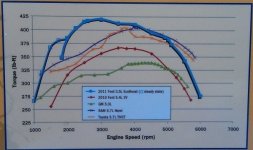Diamondpilot
Super Star Member
- Joined
- Jan 18, 2007
- Messages
- 16,331
- Location
- Daleville, IN
- Tractor
- Jinma 254/284 Ford 861 Powermaster at work
The torque chart above shows exactly why I choose the 5.7L Hemi, considering I had the Chevy 5.3L dog motor. Look at how far you gotta rev that thing to get any torque out of it. What a pig! :yuck:
The Hemi takes care of me, as I tow moderate loads sporadically. For those towing heavy loads more frequently, I would think the arguement for diesel becomes stronger because the Ford EB fuel consumption should drop quite a bit, seeing as it is still a stoicheometric gasoline engine, right?
I guess I still don't see the case for the EB engine - much more expensive than the naturally aspirated V8s, so would not buy for light/moderate towing. Poorer fuel mileage than diesel for heavy towing, and debatable durability?
:confused3:
Our EB turns in 13 mpg pulling a 20' tandem axle enclosed box trailer. That's night and day difference from the normally aspirated V8 engines we towed the same trailer with turning in 8 to 9 mpg plus the EB will pull the guts out of the V8's.
Chris
